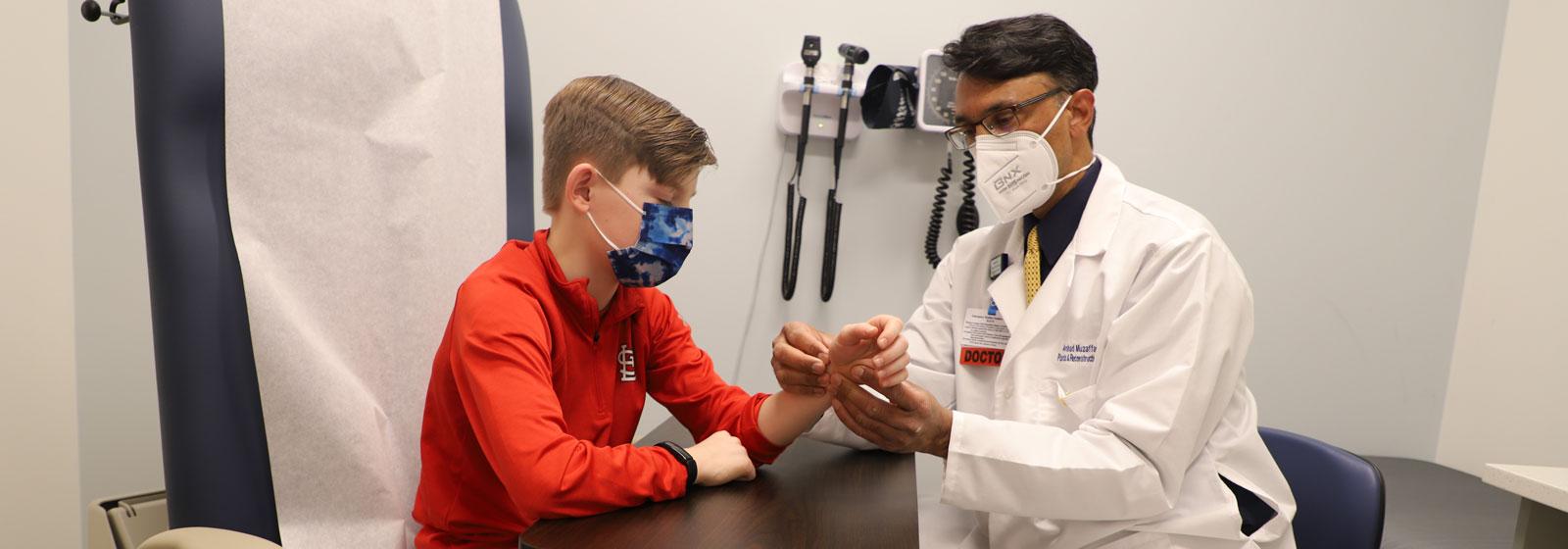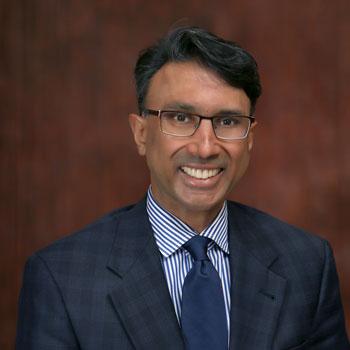Fellowship trained in hand and microsurgery, Dr. Muzaffar specializes in pediatric and congenital deformities, which are the most complex problems in hand surgery. He received his hand surgery training through a fellowship at the University of Texas Southwestern and Texas Scottish Rite Hospital for Children, a specialty orthopedic hospital that has one of the busiest congenital hand clinics in the country.
Because of his in-depth hand training, Dr. Muzaffar is experienced in treating complex problems and in using various types of techniques in both children and adults. Plastic surgeons are experts in soft tissue surgery, which includes delicate nerves, tendons, blood vessels.
Dr. Muzaffar treats the whole spectrum of hand and upper extremity acquired issues, congenital conditions and complex, trauma-related injuries.
Congenital Conditions We Treat
Syndactyly
One of the most common congenital hand anomalies, syndactyly is an abnormal fusion of fingers that create a webbed effect in one or both hands. The fingers failed to separate during fetal development. The middle and ring fingers are most commonly affected. Syndactyly limits your baby's ability to use the hands and fingers.
Different forms of syndactyly include:
- Simple, complete syndactyly. Fingers are joined by the skin and tissue from base to tips.
- Simple, incomplete syndactyly. Fingers are joined by the skin and tissue part way up the length.
- Complex syndactyly. Bones of fingers are fused together.
- Complicated syndactyly. Fingers are joined by malformed or extra bones and abnormal tendons or ligaments.
The Procedure
Syndactyly can be corrected with a procedure that separates the fingers and/or toes. Skin grafts from the lower abdomen are used to cover the skin as needed on the separated fingers or toes.
Syndactyly may be diagnosed at birth or through ultrasound before the baby is born. Soon after your baby is born, Dr. Muzaffar will examine your baby and take X-rays of the affected hand. He will see your baby in the months leading up to surgery to determine a treatment plan and explain the surgery.
For the most successful outcome and healing, Dr. Muzaffar typically performs this procedure when children are about 18 months old. However, if the little finger (pinkie) or thumb is connected to other fingers, the initial procedure may be done around age 6 months to allow for growth of the adjacent fingers.
More complex syndactyly may require surgery at a younger age. Sometimes multiple surgeries over time are needed to separate all the fingers and toes.
Polydactyly
The second most common hand anomaly, babies born with this congenital condition have an extra finger. Polydactyly usually affects only one hand or foot and can limit the use of hands
Extra fingers are usually small and not fully developed. They may be made up of skin and soft tissue, or also include bone with or without a joint. Extra fingers are most commonly on the little finger (pinkie) side. They also may be on the thumb side, which is called thumb duplication, or in the middle of the hand.
The Procedure
Polydactyly may be diagnosed at birth or through ultrasound before the baby is born. Soon after your baby is born, Dr. Muzaffar will examine your baby and take X-rays of the affected hand. He also will see your baby in the months leading up to surgery to determine a treatment plan and explain the surgery.
An experienced pediatric hand surgeon, Dr. Muzaffar works closely with you and your child to create an individualized treatment plan to ensure your child gains the maximum use of his or her hand. Timing for surgery is carefully determined so your child has the best results. Surgery is usually recommended between age 1 and 2.
Dr. Muzaffar performs surgery to remove the extra finger and reconstruct the remaining finger(s). Surgery may be simple or highly complex depending on the specific type of polydactyly. Sometimes more than one surgery is needed over time.
Different forms of polydactyly include:
-
Pre-axial polydactyly: This form is when your child has a duplicated or split thumb. Through a complex surgery, Dr. Muzaffar creates a single thumb by reconstructing the skin, soft tissues, tendons, joints and ligaments.
-
Post-axial polydactyly: This form is when your child has an extra finger outside the little finger. Treatment may include simply ligating the base of the extra finger if it is very small, or, if the extra finger is well-formed, it may require a more complicated surgery to reconstruct the soft tissues, tendons, joints and ligaments.
-
Central polydactyly: This rare form is when your child has an extra finger attached to the ring, middle or index finger. This condition requires Dr. Muzaffar to performs a complex surgery on the hand to reconstruct the soft tissues, tendons, joints and ligaments.
Radial dysplasia (radial club hand/thumb hypoplasia)
If your child has radial dysplasia or radial club hand, the structures on the thumb side are underdeveloped, abnormally developed or absent. A specialized team, including expert hand surgeon Arshad Muzaffar, MD, will develop a personalized treatment plan for your child that may include surgery and hand therapy. The goal is to improve the function and the appearance of the hand.
The effects of radial dysplasia can range from very mild to severe. This complex condition may involve only the forearm; the forearm, wrist and thumb; only the thumb; or the thumb and wrist. Children with radial dysplasia may have a slightly small thumb, a missing thumb, and/or missing wrist bones. A number of other anomalies may be present along with radial dysplasia.
In radial clubhand, the radius bone on the thumb side of the forearm is very short or absent. This causes the hand to be bent at a sharp angle to the forearm, resembling a golf club.
The Procedure
Surgery is tailored to your child's specific condition. When thumb underdevelopment is mild or moderate, Dr. Muzaffar will reconstruct a functional thumb using the tissues of the small thumb and tendons from other fingers.
If the thumb is severely underdeveloped or absent, Dr. Muzaffar will create a new thumb by moving the index finger to the thumb position and adjusting the length of it to look and function like a thumb (pollicization procedure).
Hand therapy is a key part of treatment, both before and after surgery, to help your child gain the most function.
Cleft hand
Children born with a cleft hand have a V-shaped gap in the center of the hand and may be missing one or more fingers. Usually both hands and feet are involved in this rare condition.
The extent of cleft hand can vary greatly, from a simple central gap in the hand to missing all fingers except the little finger. This condition affects hand appearance and can limit hand function. Cleft hand also be associated with other physical issues affecting various parts of the body.
The Procedure
Cleft hand may be diagnosed at birth or through ultrasound before the baby is born. Soon after your baby is born, Dr. Muzaffar will examine your baby and take X-rays of the affected hand. He also will see your baby in the months leading up to surgery to determine a treatment plan and explain the surgery.
An experienced pediatric hand surgeon, Dr. Muzaffar works closely with you and your child to create an individualized treatment plan to ensure your child has the maximum use of his or her hand. Dr. Muzaffar may perform one or more surgeries, depending on your child's unique needs. Typically, your child's first surgery will be around age 1.
The goal of surgery is to close the gap in the hand, enable the pinch and grasp function, and to reconstruct a functional thumb and the space between the thumb and index finger. Ultimately, surgery can help your child live with minimal limitations.
Other pediatric hand and upper extremity conditions treated
-
Arthrogryposis
-
Trigger finger
-
Amniotic band syndrome
-
Camptodactyly
-
Macrodactyly
-
Ulnar dysplasia
-
Symbrachydactyly
-
Brachydactyly
-
Cerebral palsy
-
Poland's syndrome
-
Brachial plexus palsy
Contact Us
To schedule a consultation or request additional information, please complete this online form. One of our team members will be in touch with you or please call (217) 214-6256 to speak to a team member.


